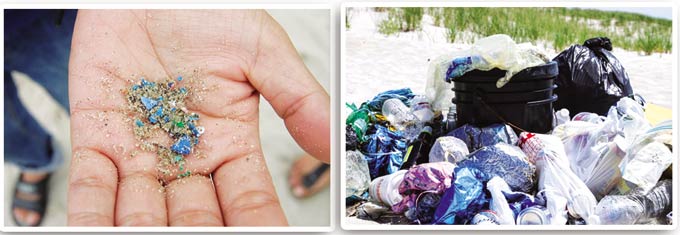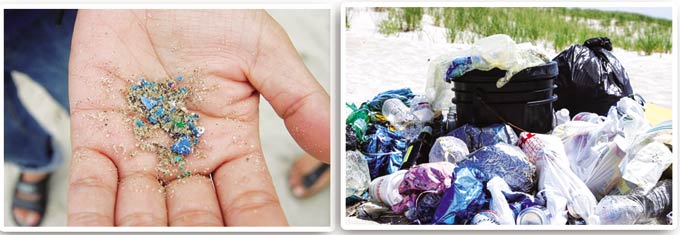Home, office or market, everywhere we use many things made of plastic. There are different types of plastic.
Nylon and polyester are also among the fabrics we wear. Plastic is a light, durable, flexible and readily available inexpensive material that can be bent into any shape. Due to these properties, plastic became popular and hundreds of commonly used items were made from plastic.
Through them, it became possible for the poor people to buy the necessary goods at cheap prices which were expensive and out of their reach due to being made of expensive materials. Therefore, plastic played an important role in making human life easier.
But now the harmful health aspects of plastic are also coming to the fore, which have made this synthetic material anti-human.
It should be remembered that the world’s first artificial plastic was “Backlight” which was invented in 1907 by the American inventor, Beckeland. It is produced by mixing phenol (a byproduct of coal) and the chemical gas, formaldehyde. After that, coal, gasoline and natural gas were mixed with various chemicals to produce different types of synthetic plastics.
After World War II, plastic varieties began to be widely produced. Today, factories around the world produce more than “40 million tons” of plastic every year. Due to the increase in population, the amount of plastic is also increasing every year. It is believed that “one billion tons” of plastic will be produced in 2050.
98% of the world’s plastics are produced from fossil fuels (petrol, coal, natural gas). More than 13 thousand chemicals are used in the production of this plastic. The remaining one to two percent of plastic is made from natural materials such as cotton, glue, resin, etc.
The most negative aspect of things made of plastic is that during continuous use, their particles keep falling which are so small that we cannot see them. Remember, if even a single drop of water drips on a stone, it will eventually make a hole in it.

Therefore, decay of substances is a natural process. Experts have divided invisible plastic particles into two groups. First, “Microplastic” (Microplastic) which is from one to five thousand micrometers. Secondly, “Nanoplastic” (Nanoplastic) whose size is less than one micrometer.
As mentioned, most plastics are made from fossil fuels (petroleum, natural gas, coal) and chemicals. Five or six years ago, some medical experts in the United States expressed their fear that plastic particles can reach the human body and cause various diseases.
This is because the particles are so small that our body cells absorb them. The particles can then cause any medical defect or defects in the cellular machinery.
When the above concern of medical experts came out, medical scientists were attracted to research, do plastic particles reach the human body and cause any kind of problems? Can a person suffer from diseases through them?
If these particles remain in the human body for a long time, can they cause negative changes? Therefore, many kinds of questions arose because fossil fuels and chemical substances, despite being beneficial to mankind, also have negative effects on human health.
The year 2023 turned out to be revolutionary in the sense that two authentic and important research reports revealing the harmful aspects of plastic came out, which created a stir in the western world. The media in Pakistan does not give importance to scientific reports, so they cannot be prominent in the country.
It should be noted that plastic items are not wasted quickly, but they decompose slowly. Thus, their particles are gradually added to the air, water and soil. When car tires rub against the road, their particles become airborne.
These then enter the body of breathing humans through the nose or mouth. Plastic particles can also be present in drinking water and food eaten. Therefore, due to the abundance of plastic products, their particles have also become abundant in the world and now every human being is entering them in one way or another every day.
First explosive report
The United Nations has started an organization, the United Nations Environment Program, to deal with environmental problems. The experts of this organization have prepared a research report on plastic particles called “Chemicals in Plastics – A Technical Report”. Compiled which was published last month.
The report revealed that of the more than 13,000 chemicals used in the manufacture of plastic, more than “3,200” are hazardous to human health. Meaning, they can make a person suffer from some disease or medical disorder.
According to the report, these dangerous chemicals especially the elderly, children and pregnant women suffer from various diseases because their immune system is weak.
God willing, if a pregnant woman falls victim to a disease due to plastic particles, she can also transfer it to her child. Similarly, there is a fear that these particles can destroy or weaken the creativity of men.
It should be noted that the fact that plastic particles can harm human health has come to light in the last few years. But there is no medical research in this regard. That is why medical experts have not been able to know what kind of damage these particles cause to humans in the short term. And what diseases do they have the potential to expose them to in the long run?
Another eye-opening report
Medical experts from three authoritative scientific institutions…Boston College, USA, Minderoo Foundation, Australia, and Center Scientifique de Monaco jointly researched that plastic products from the stage of production to use and disposal are harmful to humans. Health perks have a variety of effects. The results of this research came out in May and it also caused a stir in the medical world.
Research has revealed that men who work in heavy plastic factories are more likely to suffer from: silicosis, heart disease, chronic obstructive pulmonary disease, and lung cancer. Cancer.
Thousands of people around the world are also involved in recycling plastic items. That is, they collect waste plastic items and deliver them to factories or waste houses.
These people can also suffer from various diseases, including leukemia, lymphoma, brain cancer, breast cancer, mesothelioma, lung cancer, reduced reproductive capacity and heart diseases. are
In countries where millions of people live near plastic factories and garbage dumps, they can also be exposed to diseases. The reason is that due to proximity to plastic, more of its particles can be embedded in their body.
According to the experts in the report, these people may have the following medical disorders: Premature birth in pregnant women, low birth weight in newborns, asthma, anemia in children, heart diseases, lung problems. Chronic obstructive pulmonary disease and lung cancer.
It is clear from both reports that plastic particles can cause many serious diseases in humans, especially those who spend long periods of time in the presence of these particles. As the use of plastic products is increasing worldwide, common people can now suffer from these diseases.
Because of this, the medical experts who prepared the reports have suggested that an international agreement be made to minimize the use of plastic products so that humanity can be protected from their harmful health effects. Also, he has warned the people to reduce the use of plastic items in their daily life as much as possible.
For example, in Pakistan, bread from the oven is usually brought in plastic containers. Similarly, other food items are also packed in plastic containers. This process should be stopped immediately because the plastic particles that melt due to the hot food or drink can be incorporated into the food items and directly into our body.
Those particles do not know what they feed in the human body. It is not unlikely that they will give birth to a dangerous disease and send the person to the next place. The patient and his loved ones do not know that the disease is caused by plastic particles.
Water and drinks are also commonly found in plastic bottles. Water in refrigerators in homes is kept in plastic bottles. All the manufacturers of plastic products claim that they do not harm human health. But after the mentioned medical reports came out, it is better that everyone use plastic items carefully. And it is appropriate to abandon their use.
Also, as a precautionary measure, make it mandatory to wash your hands five to six times a day so that plastic particles, germs and viruses cannot enter the body through hands. By being careful, you can maintain the eternal wealth of your health.
(function(d, s, id){
var js, fjs = d.getElementsByTagName(s)[0];
if (d.getElementById(id)) {return;}
js = d.createElement(s); js.id = id;
js.src = “//connect.facebook.net/en_US/sdk.js#xfbml=1&version=v2.3&appId=770767426360150”;
fjs.parentNode.insertBefore(js, fjs);
}(document, ‘script’, ‘facebook-jssdk’));
(function(d, s, id) {
var js, fjs = d.getElementsByTagName(s)[0];
if (d.getElementById(id)) return;
js = d.createElement(s); js.id = id;
js.src = “//connect.facebook.net/en_GB/sdk.js#xfbml=1&version=v2.7”;
fjs.parentNode.insertBefore(js, fjs);
}(document, ‘script’, ‘facebook-jssdk’));



